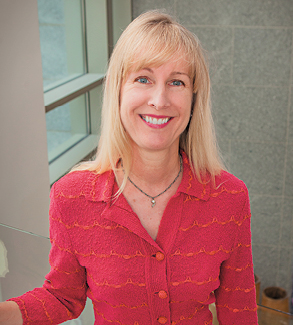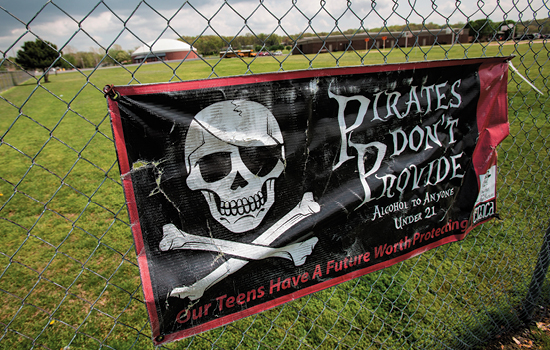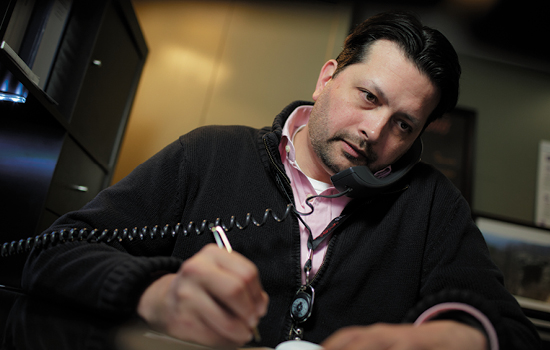Underage and under the influence
By By Martha McKenzie | Photography by Steve Nowland

As parents and auto-insurance adjusters can attest, teenagers tend to make really bad decisions. Add the influence of alcohol, and those decisions can go from really bad to catastrophic. While underage drinking is a problem across the country, costing some 4,300 youths their lives each year, it is perhaps most keenly felt by the country's native population.
American Indian teens start drinking earlier and have higher rates of alcohol-related problems than their non-American Indian counterparts. Kelli Komro, professor of behavioral sciences and health education, tested and compared two interventions in the Cherokee Nation in northeastern Oklahoma that take aim at those sobering statistics. One of the initiatives was community-based and focused on encouraging adults to more actively engage with community leaders and law enforcement officers to change attitudes and practices toward underage drinking. The other engaged teens themselves, providing specialized counseling within the schools to support healthy choices.
"So many people—adults and teens—think of starting to drink as a rite of passage," says Komro. "But before the early 20s, the brain is still developing, so alcohol is all the more damaging. And teens who drink are more likely to have problems in school, be injured, and engage in other risky behaviors, such as drinking and driving, unplanned and unprotected sexual activity, and use of other drugs."

A CONNECT poster displayed in a community convenience store.
It takes a village
The adult-focused intervention, Communities Mobilizing for Change on Alcohol (CMCA), that Komro and her Cherokee Nation Behavioral Health partners used can seem counterintuitive. Why target adults instead of the teens themselves?
Because, says Dallas Pettigrew, a social worker whom Komro recruited to oversee the intervention, there is no legal way for someone under age 21 to obtain alcohol. But obtain it they do. The younger kids typically steal it from their parents' alcohol cabinet. Middle teens, aged 15 to 17, usually get it from older kids or young adults. And 18- to 20-year-olds just buy it themselves. CMCA aimed to shut down all avenues.

Kelli Komro studied two interventions to curb teen drinking. One put the onus on adults to keep teens safe and the other targeted teens themselves. The results were surprisingly similar. |
|---|
"This strategy is not common," admits Pettigrew, who is a member of the Cherokee Nation. "It's much more typical for adults to appeal to teens to not drink, or if they do, don't drink and drive. That puts the responsibility on the teens to make safe decisions, but their brains are not wired that way yet. We wanted to put the responsibility back on the adults. It is their job to protect children."
Toward that end, Pettigrew and Komro recruited people within the Cherokee Nation communites who were concerned about underage drinking. These people then organized community action teams to identify problems in their particular neighborhoods and address them. "The fact that these teams were made up of concerned residents rather than outside professionals made a huge difference," says Pettigrew. "It's much harder to ignore a person you know, who you might see in the grocery store or the bank."
The action teams focused much of their work on convincing law enforcement officials to be more diligent in enforcing existing laws. For example, people in the community generally know where the kids go to hang out and drink. They asked police to patrol those hideouts to keep the teens from having drinking parties.
The action teams also pressed police to step up surveillance on liquor stores to make sure they were properly checking IDs and to increase the penalty for those that sold alcohol to minors. Rather than just impose a penalty on the minimum-wage clerk who made the sale, as is typical, the groups pushed police to send the penalty up to the store manager and owner with the threat of the loss of their liquor license.
And one team found that police were reluctant to go break up a party where there was drinking because they didn't know what to do with all those kids in the aftermath. "That was a concern the police had that community members weren't aware of," says Komro. "In the end, they were able to get a bunch of volunteers who said they would be willing to come when a party was raided and help supervise all the kids until their parents could pick them up. That was a great example of the community figuring out where the problems were and then strategizing to solve them."

A CMCA community action team-designed banner to support the social norm that adults in their community do not provide alcohol to underage youth.
Taking the "high" out of high school
For the intervention that targeted teens, Komro took a program typically done in a clinical setting—screening and brief intervention—and redesigned it for universal application to all high school students. The new program is called CONNECT. Partnering with the Oklahoma Department of Human Services, Komro used grant money to help hire a full-time social worker at each of the three participating schools. The social worker was then trained in motivational interviewing skills and served as a CONNECT coach in their school.
All students were screened about their alcohol use and then classified as low, moderate, or high risk. Then every student—so none felt stigmatized—got an individual counseling session each semester for the 2 ½ years of the study.
"With motivational interviewing, you aren't directly telling the students not to drink," says Komro. "Instead, you draw them out, find out what their dreams are, what their goals are, and then ask them to assess how alcohol use fits in with those dreams and goals. You're guiding the child to come to his or her own conclusion, which is much more persuasive than being told something."
Even teens who were at low risk for alcohol use had these brief counseling sessions. "We used the sessions to provide affirmation to remain alcohol free and to help them plan to stay that way," says Brady Garrett, a psychologist who oversaw CONNECT.

One of the CMCA community action teams discusses strategy.
Taking it to the streets
Both interventions were successful in curbing teen drinking, with surprisingly similar results. Both resulted in a 20 percent to 25 percent drop in current alcohol use, in heavy episodic drinking (five or more drinks at once), and in alcohol-related consequences. Even more surprising—when the interventions were combined, the results were similar. "I really thought we'd see a larger drop in the combination group," says Komro. "I'm really not sure why it's the same. Maybe that is as much of a reduction as we can currently achieve, given the larger societal context where alcohol remains actively advertised and marketed and is still thought of as a rite of passage."
The biggest difference between the interventions is cost. Hiring a school-based social worker is quite expensive, and when funding runs out, the program stops. Only one of the social workers hired in CONNECT stayed on in that capacity after the study. The community-based intervention, however, costs less and changes policies, practices, and attitudes in a way that is potentially more sustainable long term.
Either approach is a much-needed step in the right direction. "Every day we can delay a child's first drink, it becomes less likely he'll have an alcohol problem later on," says Pettigrew. "And I have to add, this study was a real blending of the research community, the intervention community, and local citizens. Typically, research gets done, it's published, and it is not accessed by everyday citizens. This study is a model of how it should be done."

Dallas Pettigrew, director of CMCA, discusses strategy with a CMCA community organizer.
